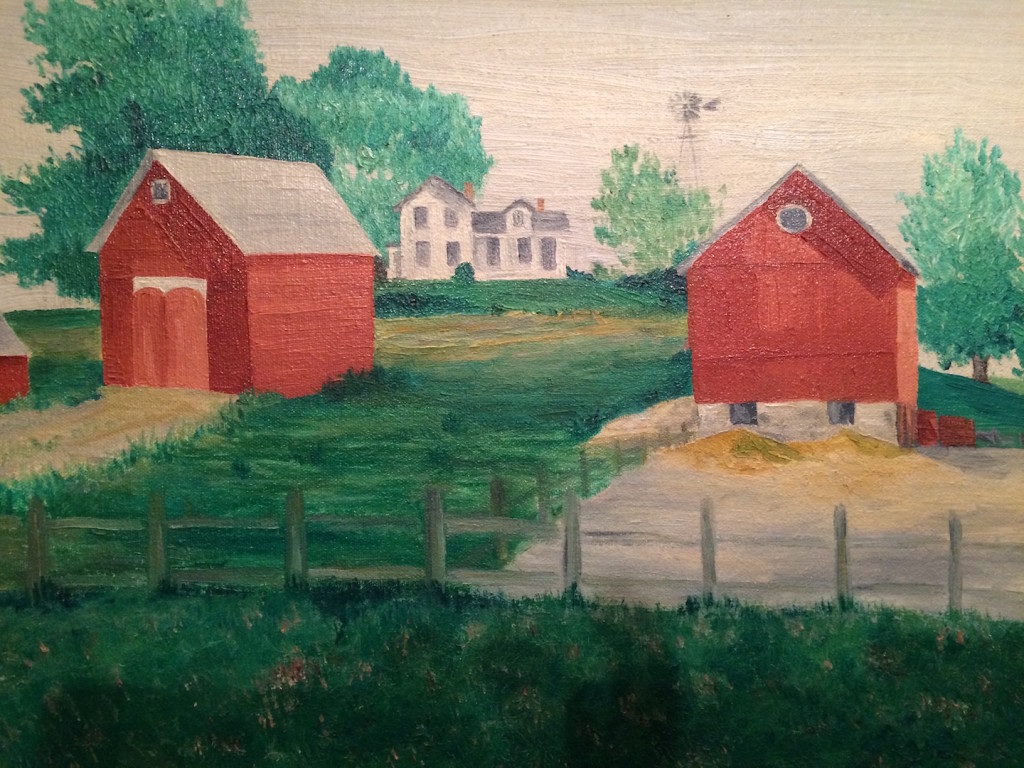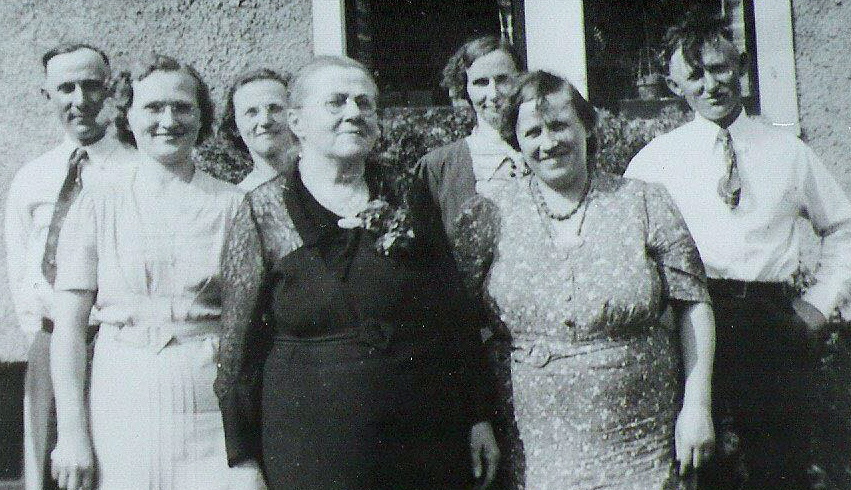I will introduce the basic biographical sketch info but this page will come alive when we add our memories of Grandma Laura (third face from the left in the photo below). Laura Clara Lena Kopfer was born on September 4, 1893. She died on August 27, 1981. She was the second of seven children born to Robert Kopher and Mary Caroline Temma. By most indications, Robert was born in Germany and Mary in DeKalb County. Only a single piece of census data recorded in Floyd Kopfer’s file indicates Floyd and Laura’s father was born in Wisconsin. Not improbable. Milwaukee and Sheboygan possessed rapidly growing German populations in the 1800’s. With all other data pointing to a German birth it simply seems unlikely that Robert was born in Wisconsin. More research is needed.
One year after Laura’s birth, her mother gave birth to a son Alfred, who died in infancy. It was not unusual for a family to lose a child at birth or shortly thereafter. Our family history contains many records of children who died young for a variety of reasons. When I research family records I frequently find a first name repeating itself with one set of parents. This was especially true when parents wanted to honor a grandparent by using their first name, or continuing a family tradition by using names from the Family Bible that previous generations used. If the first child with that name died young, the parents may give that same name to a child born after that death.
It was also not uncommon for women to die in childbirth in the centuries prior to 1900. Mary Caroline Temma Kopfer was blessed in that she survived the birth of each of her seven children. She would also tell you it was God’s will that Alfred was taken from her. She and her husband, Robert, were devout Lutherans. They were members of the Immanuel Lutheran Church in Hinckley, DeKalb County, Illinois. I would imagine that, like many German Lutherans, Laura Clara Lena was carted off to church every Sunday for worship service. That church, pictured above, stands to this day, a testimony to the rock like commitment of the original congregation.
As the church bell tolled it is easy for me to visualize the parishioners streaming into the narthex. It was a scene in my own childhood as one of Mary Caroline’s many grandchildren, Doris Weiherman Smith, cuffed my ear to tow me to the pew and away from the likes of Steve Scharnweber and John Tisch, good German youth in the 1950s.
As Laura entered church each year of her youth the siblings surrounding her grew in number. She and older brother Harvey Henry were joined by sisters: Ella, Cora, and Lily. A ‘bookend’ for the set of four girls was added when the youngest boy, Floyd, was born in 1906. I would imagine that Floyd received a lot of doting attention from his older sisters. Laura was thirteen at the time of Floyd’s birth. Oldest brother Harvey was 17 and already employed as a young man with a dubious future waiting for him.
As the Kopfer kids were marshalled into church they blended in with the children of other families from the German enclave. With Leifheits to the left of them and Rissmans to the right they were tight. As families grew in number, one family would eventually spill into another pew. One could never be sure that a pew was reserved each Sunday in one family’s name, unless of course, the elders established seating arrangements to maintain decorum and insure attendance. Such was the case in the church of some of our ancestors. A man could receive a good flogging or be forced into the stockade (often constructed at the entry to church) if he skipped a Sunday service in some of our ancestor’s New England congregations.
Immanuel Lutheran Church was clearly instrumental to the well being and sanity of the growing German community. It not only provided a shared place for reverant worship of the Lord God, but it also provided a scene for celebration and sympathetic support. On April 15, 2015 the church celebrated its’ 150th anniversary. The first service was held on Good Friday, April 14, 1865. Does that date sound familiar? It was on the evening of that date that President Abraham Lincoln attended the performance of the play at Ford’s Theater. The church played a significant role in the life of our Weiherman family and in the life of Laura. I think it wise to capture a bit more of the character of Immanuel Lutheran.
I will use the words of our own Donna Kopfer Romp Carlson, a member of the church for 85 years. Speaking in 2015 Donna
“remembers when the church at 12760 Lee Road had a lean-to to tie up horses, ice cream socials when the ice cream had to be hand-cranked, and 10-cent fried chicken suppers that asked attendees to bring two fried chickens from their farm or two pies.”
Of course, we are now familiar with the name ‘Kopfer’, but we will also find the Carlson name among the ancestors of Merle Weiherman Sawyer descendants. Donna, age 85 in 2015, is the daughter of our Floyd and Helen Kopher. Floyd was Laura Clara Lena’s brother. That first church service was held at Hartman public school and conducted by a circuit rider who served congregations in Batavia, Aurora and Yorkville. That would be quite a journey in the days of the horse and buggy. I mentioned Hartman public school for a reason. Not only did it shelter and educate our family youth but it carried the name of yet another ancestor, ‘Hartman’. Floyd Kopher married Helen Leifheit, the daughter of Charles Leifheit and Wilhelmina ‘Minnie’ Hartman.
The present day pastor, Chris Navurskis, a lifelong member of the church, reveals
“It was almost an all-rural farming congregation. Germans came to America for opportunity, and life was hard. Many died from measles, influenza and childbirth. It was the hardship that tied them all together. They formed the church to make sure that they didn’t take a secular turn in the new country.”
Laura Weiherman was alive and well in 1901 when the foundation for the present day church was laid down and the new church constructed, replacing the original structure. She was all of seven years of age. While she would probably not remember the hoopla that surrounded the ribbon cutting for the new church structure I do believe she would recall the first time the new organ was played in church. The new pipe organ was installed in 1903 and the first organist of the congregation was her mother, Mary Caroline Temma Kopfer.
I am also betting dollars to doughnuts that our Laura was becoming fluent in both the English and German language. The congregation was composed almost entirely of German farm families and was 100 percent fluent in German up until 1910. All services held from the inception in 1865 until 1910 were in German. The desire of non-Germans to join with their neighbors in the worship of God created what most considered an appropiate response: Services were held once a minth in English.
The use of German in services and on the streets phased out for several reasons:
- World War I made it difficult for our German ancestors. Germany was now an enemy, the Kaiser was a wanted man, and any German in the county was now suspected of plotting an act of sabotage. Never mind the fact that some of our boys would be giving their lives for the Ametican cause.
- Added to the impact of WWI was the simple fact that each generation was relying more on English and less on their German vocabulary. By 1936 the services were held in English.
- A German service was held once a month and that practice ceased altogether with the advent of WWII and the war with NAZI Germany.
We know a little bit now about the atmosphere surrounding Laura Kopfer as she grew to adulthood. She was German-American (at a time when it drew suspicion), raised in the Lutheran Church with devout leaders of the Immanuel Lutheran Church and the oldest girl in a family of six children and that would require her supervision.
It’s time to meet John M. Weiherman and other members of the Immanuel Lutheran extended family.
Footnotes
Cool link to Immanuel Lutheran Church history



